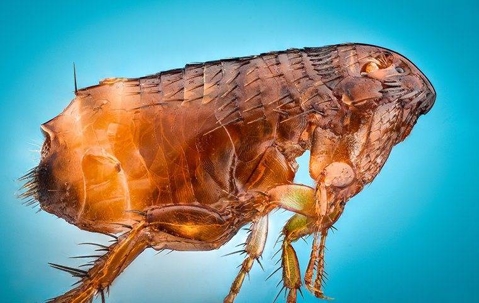Ever had that nagging worry after visiting a flea-infested place? You're not alone. The question, can fleas travel on humans to another house, is a common one. Let’s unravel the truth.
It’s not just about the discomfort of bites. It's about the risk of spreading these pests to other homes. We're going to explore how fleas move and what you can do to prevent them from hitching a ride on you.
This article aims to provide clear, practical information to help you understand and mitigate the risks. Let's ensure you don't become an unwitting flea transporter. We will be answering the question: can fleas travel on humans to another house?
Stop the flea express. Discover how to prevent fleas from traveling with you and protect your loved ones.
Table of Contents
ToggleCan Fleas Travel on Humans to Another House?
Yes, fleas can travel on humans, although it's not their preferred mode of transport. Fleas primarily prefer warm-blooded animal hosts, like cats and dogs, but they can temporarily cling to clothing or hair. This means you can inadvertently carry them from one location to another.
Fleas are adept jumpers and can easily transfer to your clothing or belongings. Once on you, they can be carried to another house, where they can then jump off and potentially infest the new environment. This is especially concerning if the new house has pets or conditions favorable for flea survival.
Therefore, while humans are not ideal hosts, the answer to can fleas travel on humans to another house is a definite yes. It's essential to take precautions to prevent this from happening.

How Fleas Travel
Fleas are incredibly mobile. They can jump significant distances relative to their size, allowing them to move between hosts and environments quickly. This jumping ability is how they often get onto humans and then off again.
They can also travel on objects like blankets, bags, and shoes. Anything that comes into contact with an infested area can become a vehicle for flea transportation. This is why it's crucial to be mindful of where you place your belongings when in a flea-infested environment.
Understanding how fleas travel is vital for preventing their spread. It's not just about direct contact with animals; it's about being aware of the environment and the potential for fleas to hitch a ride on you or your belongings.
Risks of Human Transmission
The primary risk of human transmission is the spread of fleas to uninfested homes. This can lead to new infestations, especially if the new home has pets. Fleas can quickly multiply, creating a significant problem.
Additionally, fleas can bite humans, causing itchy and uncomfortable welts. While they don't typically live on humans long-term, they can use us as a temporary food source and transportation.
The risk extends beyond just discomfort. Flea infestations can be challenging to eradicate, requiring extensive cleaning and treatment. Preventing human transmission is a crucial step in flea control.
Preventing Flea Travel
Several steps can be taken to prevent fleas from traveling on humans. One of the most important is to avoid contact with known flea-infested areas. If you must enter such areas, take precautions.
Wear clothing that covers as much skin as possible. Light-colored clothing can also help you spot fleas more easily. Immediately wash and dry clothing on high heat after visiting potentially infested areas. Vacuum your car and home thoroughly.
Showering and washing your hair immediately after potential exposure can also help remove any fleas that may have attached themselves. These simple steps can significantly reduce the risk of bringing fleas into your home or another person's home.
Conclusion
Understanding can fleas travel on humans to another house is crucial for preventing their spread. While humans are not the ideal hosts, we can inadvertently transport these pests. By taking preventive measures, you can significantly reduce the risk of spreading fleas. Stay vigilant and keep your home and loved ones flea-free.
Frequently Asked Questions - FAQS
Q. Can fleas live in human hair?
A. Fleas prefer animal fur but can temporarily live in human hair. They don't thrive there long-term.
Q. How long can fleas survive on clothing?
A. Fleas can survive on clothing for a few days, depending on conditions. Washing and drying on high heat kills them.
Q. Can I see fleas jumping on me?
A. Yes, fleas are visible to the naked eye, especially on light-colored clothing. They jump quickly.
Q. What are the signs of a flea infestation in a house?
A. Signs include itchy bites, seeing fleas jumping, and finding flea dirt (black specks) in carpets or bedding.
Q. Can fleas travel on furniture?
A. Yes, fleas can travel on furniture, especially fabric-covered pieces. Vacuuming and cleaning are essential.
Q. How do I get rid of fleas on my clothes?
A. Wash clothes in hot water and dry them on high heat. This kills fleas and their eggs.
Q. Can fleas survive in a car?
A. Yes, fleas can survive in a car, especially if it's warm and there are fabric surfaces. Vacuum thoroughly.
Q. What are natural flea repellents for humans?
A. Essential oils like peppermint and eucalyptus can repel fleas, but they are not always effective.
Q. Can fleas transmit diseases to humans?
A. While rare, fleas can transmit diseases. It's best to avoid flea bites altogether.
Q. How often should I vacuum to prevent fleas?
A. Vacuuming daily is recommended during an infestation. For prevention, regular weekly vacuuming is sufficient.

